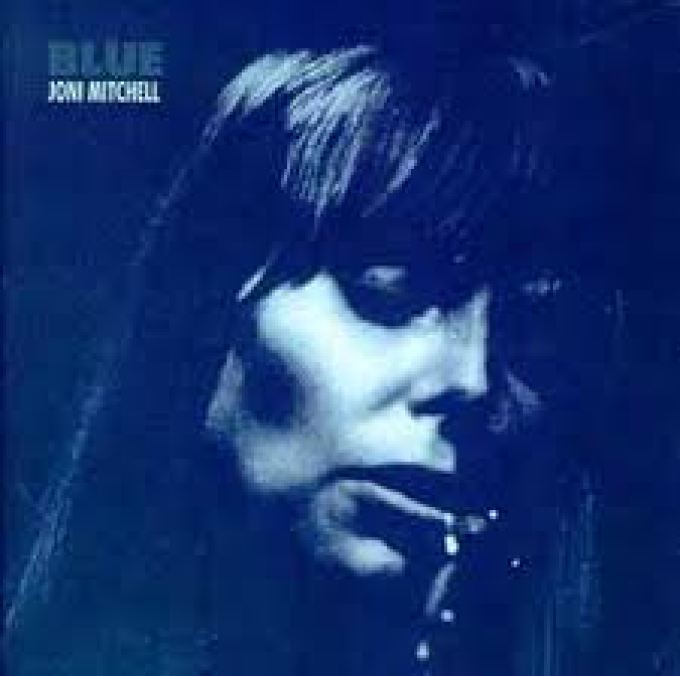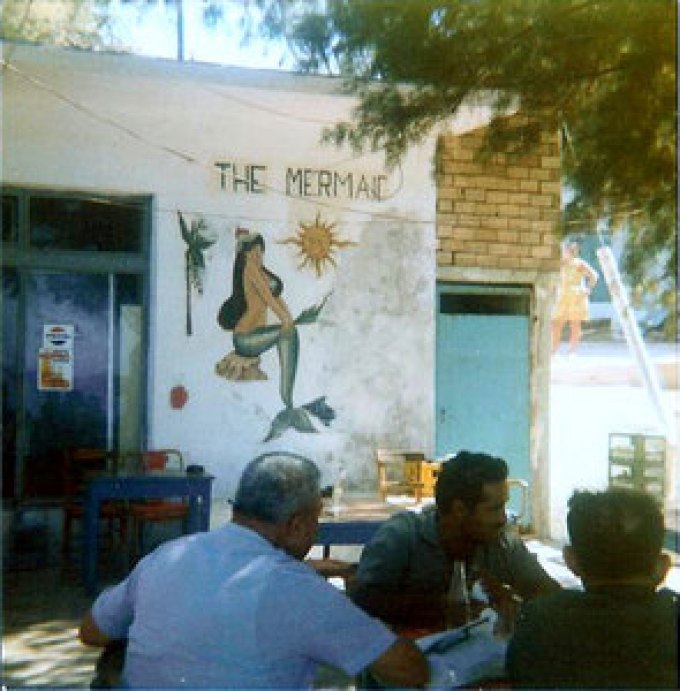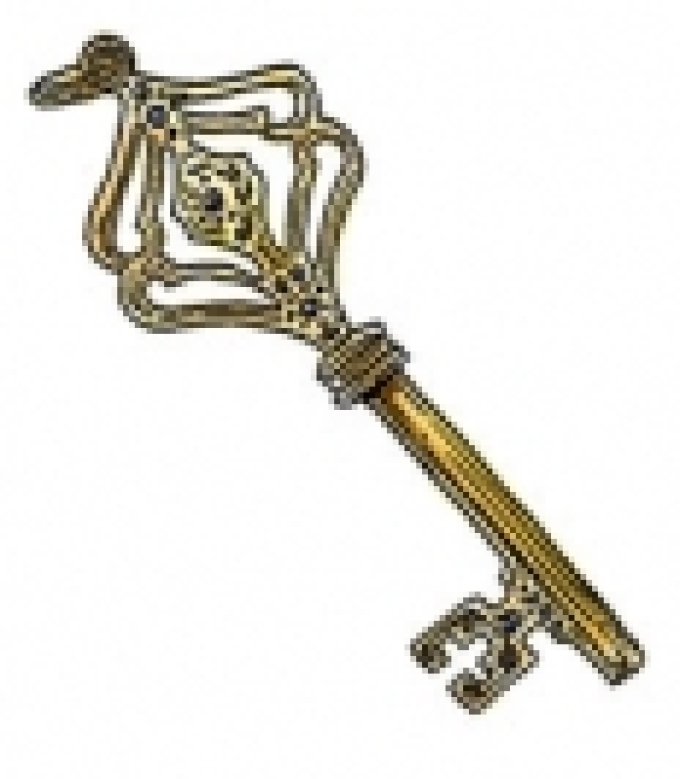(I wrote this appreciation in 2010. Blue was released on this day 50 years ago. I’m so pleased to see the world recognizing it — perhaps more than any album in history. The New York Times devoted a fine piece to it, with the thoughts of 25 musicians on each song. I also felt the need to detail this masterpiece song by song)
I’ve heard it said that it’s easier to learn from art that’s less than great. The same is true of criticism. It’s easy to describe the machinery in flawed works. Works of genius are tougher – the very things that make them great are those leaps beyond what’s been done before, beyond what follows the formulas lesser artists employ to crank out their stuff.
So, with a mezzo-piano note of trepidation, here’s my take on a masterpiece.
Joni’s a painter, and doesn’t stint on the color of the title. Her face is drowning in blue on the cover. The word “blue’ or “blues” appears in over half the songs. She makes musical puns with it. Though none of the songs are remotely 12-bar blues, she adds blues flourishes around the “blues” in “California” and “All I Want.” And the final chord of the title song is a dominant 9th, the signature blues chord.
Joni starts “All I Want” with a dulcimer riff that starts and stops, hesitant– and why not? Because this song’s a bumpy ride. But she sees no choice, she’s gotta go.
“I am on a lonely road …” The song abounds in internal rhymes and repetitions. They serve as incantations, as if by rhyming things she can make them fit together, and by repeating them they will become true. “Alive alive, I want to get up and jive I want to rip my stockings in some jukebox dive.” “Applause applause, life is our cause, when I think of your kisses my mind see-saws…” followed by “Do you see, do you see, do you see…” –the “see” a homonym for the see in see saw; if she sings it enough times he will see. She introduces an emotional see-saw even before singing that word, in the melody, which rises, falls then rises on “I want to be strong I want to laugh along I want to belong to the living.”
The heart of this heart-filled song and of the whole albumis “Looking for the key to set me free.” Her hope in the magic of this internal rhyme – key and free-echoes the deepest hope of the whole 60s counterculture of which Joni was the finest spokesperson. She’s not selfish, only wishing for her own freedom. In the last line she sings, “I want to make you feel free.” Not just the man she’s singing to, but all of us who listened, who still listen.
And she did free us, which helps explain the enduring popularity of this album. She made some feel free to love. Others she made free to feel. In the grisly aftermath of a bad love affair I first found in Blue access to the tears denied me by parents. I’m not alone.
The freedom Joni offers in “My old man” applies explicitly to relationships; “We don’t need a piece of paper from the city hall, keeping us tried and true, my old man, keeping away my blues.” Here also is the tension that runs throughout the album: the frequent price for the freedom to feel is feeling blue. But there’s hope in love.
Joni reveals another freedom in this song, one she’ll be taking more and more often. Musical freedom. The melody on “piece of paper from the city hall” is liberated from the confines of folk and pop music, into the chromaticism of jazz.
“Little Green” was the song I used to skip on the record. It’s the only throwback to a simpler folky style. I didn’t know it was a long sleeper, which would awaken when I discovered she wrote it about the daughter she abandoned to adoption, and whom she happily reunited with decades later. I don’t skip that song anymore. “Little Green, have a happy ending.” Apparently she, and they did.
“Carey” is as unblue as Joni allows herself to get on this album. It’s sheer fun, sung by the Goddess of the hippies. What chick among us didn’t dream she was Joni, living it up at the Mermaid Café, and what guy didn’t wish he could be there with her?
The Mermaid Cafe
Even here there’s an edge – it’s a song of goodbye. And there’s that unsettling cane. “Oh you’re a mean old daddy….” Whatever he’s into, she’s digging it. He’s “out of sight” belted out with a grin that evokes a lifetime of erotic pleasures.
“Blue.” Well, the fun didn’t last long. “Blue, Songs are like tattoos…” here the sorcery in rhyme turns dark. Still by the end of the verse she’s rhyming blue with “I love you,” revealing another aspect of the title emotion. If love is filled with uncertainty, there’s comfort in sadness, especially if it’s the constant companion it clearly is with this singer. Often though, it just hurts. What’s sadder than the way she sings, “Lots of laughs, lots of laughs” ?
Side Two (Yes, it was a record, with sides that meant something. They still do.)
“California” is for Joni a fairly uncomplicated love song: because the object of her affection is not a difficult human, but a sunny place. It’s a place I also love. I go there at least once a year, and every time my plane sets down at McLaren Airport that song’s playing in my head. The opening lines perfectly capture the feeling of political hopelessness by the start of the 70s:
Sitting in a park in Paris, France
Reading the news and it sure looks bad
They won’t give peace a chance
That was just a dream some of us had
She asks her love, California, “Will you take me as I am? Strung out on another man?” meaning Europe, “old and cold and settled in its ways.” By the end when she sings, “Will you take me as I am? Will you?” her meaning has expanded to elaborate on the theme of freedom. Because how can we be free to be who we are unless our lovers, unless the world, accepts who we are?
“This Flight Tonight” is a lesser song, though it has the searing line, “Oh blackness blackness, dragging me down/Come light the candle in this poor heart of mine.” My favorite moment is the song-within-a-song playing on the headphones in the plane, “They’re playing ‘Goodbye baby. Baby Goodbye, Ooh, Ooh, love is blind,” rendered with such verisimilitude that it pulls you right into the seat next to her,
“River.” It’s the only song on the record with a reasonable enough range for me to sing, which is probably also why it’s her most covered song. But there’s nothing limited in its emotional depth, though she really only hits one note: sad. She’s alone with her piano, quoting jingle bells. She plays the first phrase major, as in the original. Then in the minor. Then over a major seventh – her favorite bittersweet chord. The contrast between people “singing songs of joy and peace” and this heart-rending tale is what makes the song. It gathers added weight for the many of us with less than brilliant memories of family Christmases.
What person who’s ever heard this song hasn’t wished at one time or another that they too had “a river they could float away on?”
“A Case of You.” The greatest song on “Blue.” No other song ever written comes as close to explaining the mystery of how two separate people can be so close, causing such joy yet such pain, and how no matter what happens those connections last a lifetime. Scientists may try to understand, but they’ll never approach the poetry of this chorus:
Oh you’re in my blood like holy wine
You taste so bitter and so sweet
Oh I could drink a case of you darling
And I would still be on my feet
Oh I would still be on my feet
Powerful words sung with an unforgettable melody. But what knocks me on my ass every time is their marriage, the tone painting this painter achieves. We hear the habit this lover’s become in the rocking repeated notes of “I could drink a case.” the “you” is rendered in loving mellisma the first time, then later by wild acrobatic leaps of passion. But no! she’s not drunk, she’s telling us, for she sets the words “My feet” evenly, later than we expect, flat on the beat like the exaggerated steps of an inebriate.
The intro to this “A Case of You” echoes the intro to “All I Want.” It’s also on dulcimer, and also hesitant. But this is the hesitation of someone who doesn’t want to go over it again, but has too. A place we’ve all been. And perhaps – how can we know? – it’s also the hesitation of a great artist on the threshold of her greatest masterpiece.
That chorus is enough to break anyone’s heart. But the climax of the song is in these lines, in which she makes explicit the magical power of the blues, to transform pain into pleasure:
And I remember that time you told me, you said
Love is touching souls
Surely you touched mine
Cause part of you pours out of me
In these lines from time to time
And here for a moment I feel her brush painting over in this darkest indigo, and see a younger, brighter Joni, for whom “the sun poured in like butterscotch.”
“The Last Time I saw Richard” offers a clear warning: stay too long embracing that beloved blue and you’ll end up “Cynical and drunk and boring someone in some dark café.”
I hear wider things in this song. There’s a hint in her evocation of “’68”, that supernatural year in the counterculture. The dark cafe of the song is the time after the bright 60s. In the last lines she is singing for all of us who once dreamed ourselves “stardust, golden.”
Only a dark cocoon before I get my gorgeous wings
And I fly away
Only a phase, these dark cafe days
As fine an epitaph for the 60s as you’ll find. The longevity of Bluesuggests that it didn’t all end then. That many of us who dreamed are still looking, will always be longing for that key to set us free.
Golden Key by Ellen Brundige
In case you missed it, here’s my very first post, describing seeing her in concert April 1969.



